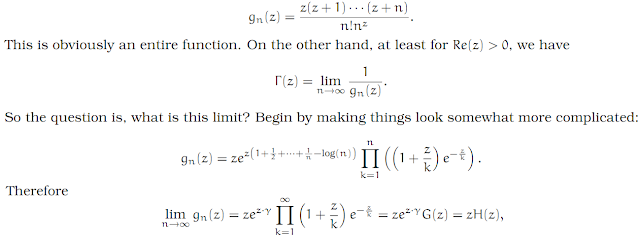Complex Analysis: #27 The Gamma Function II
for x a real number greater than 1, which we used in the analysis lectures? Going from real to complex numbers, let us write z = x + iy. Then we have
Therefore — as we saw in Analysis I — the integral defining the gamma function will again converge when x > 1; for x < 1 it diverges.
As an exercise, we see that for z = x + iy and x > 0, we have
This is another standard formula for the gamma function, and in fact it is valid as long as Re(z) > 0. But we still haven’t shown that it is the same gamma function as that which was defined in the previous section.
For each n ∈ ℕ, let
and we see the connection with the definition in the previous section.
As a final remark before proceeding with Stirling’s formula, I should mention that Legendre introduced the beta function, which is
This seems to be used these days in computer algebra programs. Also, when on that subject, one finds many interesting and obscure formulas related to the gamma function. (You can also look in books containing tables of mathematical formulas.) One such formula which caught my eye is the following. Let n ∈ ℕ. Then
Here n!! is the double factorial. That is







No comments:
Post a Comment
If it's a past exam question, do not include links to the paper. Only the reference.
Comments will only be published after moderation